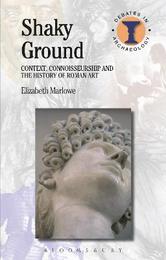
|
Shaky Ground: Context, Connoisseurship and the History of Roman Art
Paperback / softback
Main Details
| Title |
Shaky Ground: Context, Connoisseurship and the History of Roman Art
|
| Authors and Contributors |
By (author) Elizabeth Marlowe
|
| Series | Debates in Archaeology |
|---|
| Physical Properties |
| Format:Paperback / softback | | Pages:184 | | Dimensions(mm): Height 216,Width 138 |
|
| Category/Genre | Classical Greek and Roman archaeology |
|---|
| ISBN/Barcode |
9781474234665
|
| Classifications | Dewey:937 |
|---|
| Audience | | Tertiary Education (US: College) | |
|---|
| Illustrations |
c. 20 bw illus
|
|
Publishing Details |
| Publisher |
Bloomsbury Publishing PLC
|
| Imprint |
Bloomsbury Academic
|
| Publication Date |
23 April 2015 |
| Publication Country |
United Kingdom
|
Description
The recent crisis in the world of antiquities collecting has prompted scholars and the general public to pay more attention than ever before to the archaeological findspots and collecting histories of ancient artworks. This new scrutiny is applied to works currently on the market as well as to those acquired since (and despite) the 1970 UNESCO Convention, which aimed to prevent the trafficking in cultural property. When it comes to famous works that have been in major museums for many generations, however, the matter of their origins is rarely considered. Canonical pieces like the Barberini Togatus or the Fonseca bust of a Flavian lady appear in many scholarly studies and virtually every textbook on Roman art. But we have no more certainty about these works' archaeological contexts than we do about those that surface on the market today. This book argues that the current legal and ethical debates over looting, ownership and cultural property have distracted us from the epistemological problems inherent in all (ostensibly) ancient artworks lacking a known findspot, problems that should be of great concern to those who seek to understand the past through its material remains.
Author Biography
Elizabeth Marlowe is Assistant Professor of Art and Art History at Colgate University, USA.
ReviewsMarlowe's book casts a raking light on a central problem long-embedded in scholarship on the history and meaning of Roman art-the practice of using "ungrounded" works (those for which little or no excavation history is available) as historical evidence. Many such works currently populate textbook histories of Roman art almost solely based on their style. The traditional reliance on connoisseurship and circular reasoning to underpin chronological and aesthetic judgments concerning these works comes in for especially sharp criticism. Advocating for a more holistic, socio-historical approach, Marlowe demonstrates how "grounded" works from controlled excavations can change the traditional picture. By taking account of the wide array of physical and historical evidence that accompanies "grounded" works, one can construct a far more complex story of how Roman art developed and functioned, and what it meant in the society of its time. This bold and refreshing look at traditional practices and assumptions will surely raise the awareness of-and stimulate debate among-archaeologists and art historians who must grapple with incomplete evidence to construct meaningful histories of Roman art. -- Elaine K. Gazda, University of Michigan, USA This provocative book challenges basic assumptions about what we know of ancient art, how we have come know it, and the ways we disseminate it. Professor Marlowe offers salutary insights not only for teachers and students of the Roman past, but also for art historians and archaeologists of all stripes. -- Kenneth Lapatin, Department of Antiquities, The J. Paul Getty Museum, USA Shaky Ground offers compelling arguments for change in the classroom, scholarship and museum. It is a must read for its critique of the use of ungrounded canonical works in textbooks, survey courses, and exhibits. Shaky Ground is also an important work of synthesis that brings together scholarship on the historiography of Roman art, the history of collecting, and debates over cultural property. Its concise discussions of these topics, together with their bibliographies, will make excellent introductions to interested readers. * Bryn Mawr Classical Review *
|